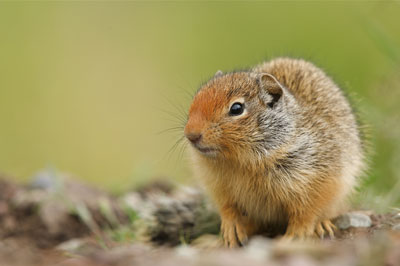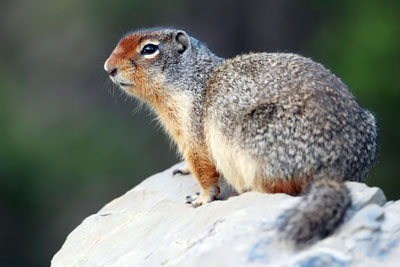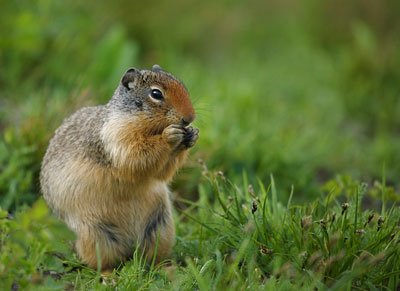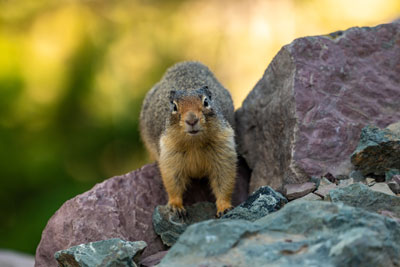




There are several species of ground squirrels found in Montana, and they can be serious problems. All are small, burrowing rodents and the control methods are the same. You need to make sure that you have ground squirrels and not pocket gophers, as control is different. Pocket gophers spend a good deal of time underground creating extensive burrow systems and mounds of dirt above ground. Ground squirrels are burrowers, too, but do not leave the mounds of dirt. If you are using lethal methods, make sure that you are targeting ground squirrels and not the white-tailed prairie dog, which is protected in Montana.
In urban areas, garden crops, flowers, ornamentals, and lawns are damaged by eating and burrowing. In rural areas, agricultural crops and pasture are the chief areas of damage. Both ground squirrels and prairie dogs are hosts to the fleas that may transmit bubonic plague. Rodent die-offs may signal plague in a ground squirrel or prairie dog population. Pets, especially cats, have been a source of infected fleas. Pets feeding on dead or dying animals may pick up the fleas and bring them home. Your pets, and ultimately you, can be protected by controlling fleas on your pets.
For small populations of ground squirrels and/or in urban areas or yards, trapping may be an effective tool to control ground squirrels. Small wire-mesh live traps, rat traps or Conibear #110 body traps are easy ways to catch ground squirrels. Live traps can usually be purchased though garden supply, sporting goods, or feed stores. Traps baited with sunflower seeds, oatmeal, grain, and/or peanut butter are effective. Oatmeal rolled in peanut butter is effective bait. Pre-baiting live traps for several days with the door propped open will get the squirrels used to coming into the trap. Rat traps may be placed down in burrows and conibear traps over the burrow entrance and may not need to be baited.
A simple live trap can be made using a 12″ by 20″ piece of ½″ mesh hardware cloth. Bend the hardware cloth to form the rectangular body of the trap with 3″ openings on either end. Secure the free edges with hog rings or wire. Cover one of the open ends with a 3″ square piece of hardware cloth. Make a trap door at the opposite end by using a 2¾″ by 8″ piece of hardware cloth. Attach this piece to the top of the trap, recessed about ½″, and make sure it can swing freely (Cooperative Extension, Institute of Agriculture and Natural Resources, University of Nebraska). The one-way door allows squirrels to enter but not exit.
For small populations of ground squirrels, shooting may also be an option. It is illegal and unsafe to discharge firearms within many cities, but it may be legal if done with air rifles or pellet guns. Check your local ordinances and decide if it would be not only legal but safe within your area. Shooting is time-consuming and squirrels quickly become gun-shy.
In certain small areas, fencing may be useful, but in larger areas it is impractical. Fencing of individual trees, ornamental plants, flower beds, or vegetable gardens may be an option. Fencing constructed of ¼ to ½″ hardware cloth should be buried at least 18 or 20″ deep and be 18″ high. Because of the cost and time to construct this type of barrier, it is expensive and practical only for small areas.
Occasionally flooding of burrows may persuade ground squirrels to relocate.
Rodenticides, anti-coagulants, and other poisons are available and most economical for large populations of squirrels, but they can only be used by a licensed pest control operator. These are poisons and are potentially harmful to people, pets, and other wildlife, and should be handled with utmost care. Consequently, we do not recommend poisons for most situations. Fumigants are also effective on burrowing animals. Some of these are also for use only by licensed operations and others are available through garden centers or feed stores. Fumigants are placed directly in burrows and rely on adequate soil moisture to activate. Instructions for fumigants must be followed exactly. Remember these are poisons and also potentially hazardous to humans and pets.
Controlling Ground Squirrel Damage. 1998. Texas Wildlife Damage Management Service. San Antonio, TX.
Ground Squirrels. 1982. J.A. Chapman and G.A. Feldhamer (eds.),Wild Mammals of North America. Baltimore: The Johns Hopkins University Press.
Prevention and Control of Wildlife Damage. 1994. Cooperative Extension Division. Institute of Agriculture and Natural Resources. University of Nebraska, Lincoln, NE.
Wild Neighbors: The Humane Approach to Living with Wildlife. 1997. John Hadidian, Guy Hodge and John Grandy, eds. The Humane Society of the United States. Washington, D.C.
